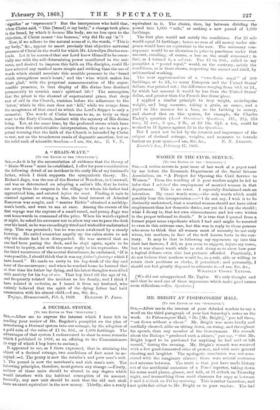A DECIMAL SYSTEM.
[TO THE EDITOR OF THE "SPECTATOR.]
SIR,—Allow me to express the interest which I have felt in reading your review of Mr. Bagehot's pamphlet on the plan of introducing a Decimal system into our coinage, by the adoption of a gold coin of the value of /1 Os. 10d., or 1,000 farthings. The advantages of that system I endeavoured to show in some remarks which I published in 1858, as an offering to the Commissioners (a copy of which I beg leave to enclose).
It appeared to me, as I there expressed, that in attaining the object of a decimal coinage, two conditions of fact must be accepted :-1. The penny is now the retailer's and poor man's unit. 2. The pound is now the merchant's and rich man's unit. The following principles, therefore, must govern any change :—Firstly, neither of those waits should be altered in any degree which would interfere with the habitual conception of its amount. Secondly, any new unit should be such that the old unit shall have an exact equivalent in the new money. Thirdly, also a ready
equivalent in it. The choice, then, lay between dividing the pound into 1,000 "sails," or making a new pound of 1,000 farthings.
The first plan would not satisfy the conditions. For 25 mils would equal 24 farthings ; hence no sum of old money under sixpence would have an equivalent in the new. The necessary consequence would be an alteration in price in purchases under that amount, entailing, of course, a loss on the small consumer ; in fact, as I termed it, a mu-tax. The Os. 10(1., called in my pamphlet a "pound royal," would, on the contrary, satisfy the conditions, as is there shown, respecting the second and third, by arithmetical working.
The near approximation of a "two-form royal" of 200 farthings, or 4s. 2d., to many European and the United States' dollars, was pointed out ; the difference ranging from .01d. to 2d., by which last amount it would be less than the United States' dollar, and greater than the French five-franc piece.
I applied a similar principle to troy weight, avoirdupois° weight, and long measure, taking a grain, an ounce, and a yard in like manner for a base, as the farthing in money, and showed that on this system, for example, Sir Charles Pasley's question (Lord Ooerstone's (2uestions, ill., 28), 215 tons, 17 cwt., 3 qrs., 9 lb., at £9 us. 6+41. a ton, could be worked in 41 figures against 55 in the Questhms.
But I must not be led by the interest and importance of the subject of decimal coinage, weights, and measures to intrude
further on your space.—I aui, Sir, &c., E. N. ATItTON. Lincoln's Inn, Febrnary 17, 1869.


































 Previous page
Previous page